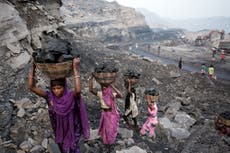How climate crisis will force 40 million girls into child marriage by 2050
Research highlights connection between increasing climate-related disasters and how it is creating emergency hotspots for girls’ rights
The number of girls at extreme risk of facing the devastating impact of both climate crisis and child marriage is set to increase to nearly 40 million by 2050, a new report has warned.
While an estimated 29.9 million adolescent girls reside in countries where the risks of both early marriage and life-changing climate disasters are highest, this number is expected to increase about 33 per cent.
“The risks to girls are real. It’s the risk of sexual harassment and abuse girls face in the chaotic aftermath of a disaster, where overcrowding and lack of safe services leave them exposed,” said Shruti Agarwal, a senior adviser at Save the Children.
“It’s being forced to marry before they reach 18, as families are pushed into poverty by years of droughts and forced to make impossible decisions about which mouths to feed. The global climate crisis is already changing girls’ lives and futures. Yet despite these unequal impacts, less than 2 per cent of national climate plans across the globe mention girls,” she added.
“Current spending almost ignores children entirely – this needs to change.”
Nations in sub-Saharan Africa and South Asia, particularly Bangladesh, Chad, and Guinea, which are highly vulnerable to climate crisis and already reeling under mounting impacts, are going to be most severely impacted, the report released by global NGO Save the Children on Tuesday warned.
The report titled “Girls at the centre of the storm: Her planet, her future, her solutions” was published on the eve of the International Day of the Girl Child.
The research highlights the connection between increasing climate-related disasters and how it is creating emergency hotspots for girls’ rights, exacerbating the challenges faced by girls in these regions.
Poverty, gender inequality, conflict, and hunger further compound the issue, making girls more vulnerable to both child marriage and the impacts of the climate crisis.
Girls married young are far less likely to stay in school, with lifelong economic impacts. They are often isolated, and they are at higher risk of physical and sexual violence. Child brides are also at greater risk of experiencing dangerous complications in pregnancy and childbirth, the NGO said.
Join our commenting forum
Join thought-provoking conversations, follow other Independent readers and see their replies
Comments


Bookmark popover
Removed from bookmarks